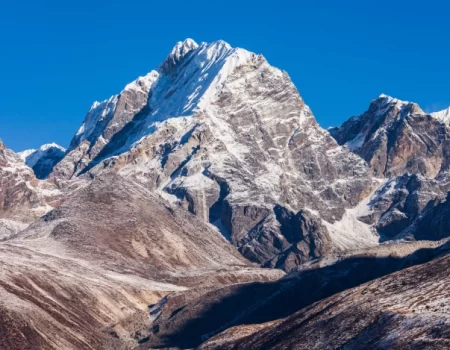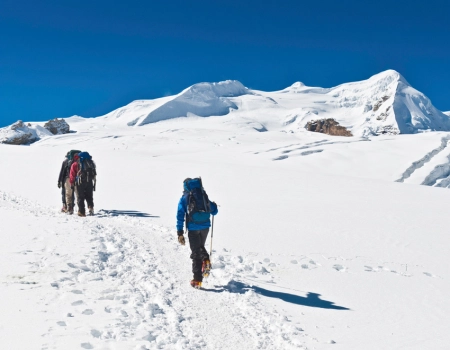Peak climbing is one of the most adventurous and thrilling activities in Nepal. Let’s say it’s one of the lifetime experiences that will be in your memory for a long time. Nepal serves as one of the best destinations for mountaineering. Among the different mountains over 8,000 meters in the world, Nepal holds the majority of them.
Since the foundation of the Nepal Mountaineering Association (NMA) in 1978, the popularity of peak climbing has grown hugely. Over thousands of mountains at a height >6000m, numerous >5000 and >4000m, spread from east to west, are available for peak climbing. Nevertheless, the world’s highest peak, Mt. Everest, locally called Sagarmatha, is the center of attraction for climbers who want to make a name for themselves in history.
Thousands of climbers from across the world have already kept their feet on the top of mountains with a height of more than 6,000 meters. It is also called rock climbing because the mountains are just rocks covered with snow, which enhances their beauty. Peak climbing in Nepal is ideal for every climber because Nepal offers several mountains for every level of climber.
Are you the one who has already experienced mountain climbing or is still a beginner but excited to do peak climbing? Blue Lake Travels and Tours offers you a peak-climbing service that will help you achieve your lifetime experience.
Climbing Packages
Why Peak Climbing in Nepal?
Peak Climbing in Nepal takes you on an adventurous journey of mountaineering in Nepal. Because of the variety of mountains with different heights, it is best suited for every level of climber. Also, NAMB has classified the climbing peaks into two categories: trekking peaks and expedition peaks.
Trekking Peaks are moderately easy and those with little or no climbing experience can easily have this peak climb with better guides. Whereas Expedition Peaks are considerably challenging and require technical climbing experience,
For beginners, trekking peaks are more suitable and you can proceed with peak climbing on different mountain peaks less than 6000 meters. In Nepal, you can have plenty of opportunities for climbing and mountaineering. You can have your experience in peak climbing at more than dozens of peaks in the Himalayan region of Nepal.
Whereas, if you are experienced in peak climbing and have some fitness and technical skills, you can go for peaks in the 8,000-meter range. However, the peaks above 6,500m are under the surveillance of the Nepal Tourism Ministry. So, if you want to climb the peak above 6,500m, you have to get permission from the Nepal Tourism Ministry.
Moreover, the mountain peaks ranging from 5,800m to 6,590m are regulated by the Nepal Mountaineering Association.
Nepal has Everest Region, Annapurna Region, and Langtang Region as major peak climbing destinations. You can have peak climbing in these regions with Blue Lake Travels and Tours, where we offer more than 15 itineraries. There are several mountain peaks in the regions of Nepal where you can have your peak climbing experience with our best guides and assistance.
In the Everest region, you can do peak climbing on mountain peaks like Mera Peak, Island Peak, and Ama Dablam Expedition. With a better fitness level, courage, and help from us, you can climb these peaks without going through any difficulties. These peaks are popular among different climbers and provide you with the best experience of peak climbing.
Similarly, Pisang Peak, Tent Peak, Dhampus Peak, Chulu Far East Peak, and Chulu East Peak are the major and popular mountain peaks to climb in the Annapurna Region. Annapurna Region is popular for its different trekking destinations, natural beauty, and cultural diversity among different trekkers, climbers, and travelers.
In addition, you can also go peak-climbing on the Yala Peak of the Langtang Region.
Why Peak Climbing in Nepal with Blue Lake Travels and Tours?
Blue Lake Travels and Tours is a government-registered travel agency in Nepal. We have been serving our clients with different trekking, tours, sightseeing, peak climbing, and expedition climbing packages with better services for decades. Along with trekking and tours, our peak climbing packages are also very popular among visitors visiting Nepal.
In addition to being a member of the Nepal Mountaineering Association (NMA), we have been providing safety and services for peak climbing in different regions.
With Blue Lake Travels and Tours, you can have peak climbing packages varying from ‘easy to moderate’, ‘moderate to difficult’, and ‘difficult to challenging’. This category is best suited for every level of climber. Beginners with little to no technical climbing experience can have easy to moderate peak climbing.
Whereas those with technical climbing experience can have moderate to challenging peak climbing.
We have the best, most experienced, and most skilled expedition guides who have years of experience in guiding peak climbing and will help you throughout the peak climbing journey. The guides we have have these skills, qualifications, and training certificates obtained from the Nepal Government:
- Basic Mountaineering Courses
- Introductory Rock Climbing Course
- Basic Mountain Rescue Training
- Wilderness First Aid Course
- Security and Mountain Aid Training
- Nepal Academy of Tourism and Hotel Management
We have several years of experience providing peak climbing to different climbers across the world. Because of the best services we provide, we stand as one of the best peak-climbing agencies in Nepal. With us, you can have these services while peak climbing on different peaks in different regions:
- Skilled and Experienced Peak Climbing Guides
- All Necessary Climbing gear
- Accommodation facilities on the Base Camp
- Peak Climbing in different Peaks of Nepal
- Certifications after successfully accomplishing the climb
- Post-Celebrations
- Pre-Climbing Training and Session
Best Time to Have Peak Climbing in Nepal
Peak climbing in Nepal can be done throughout the year but is highly dependent on the specific reason and peak you are trying to conquer. The autumn and spring seasons are the primary seasons for peak climbing in Nepal.
Spring (March to May) and autumn (September to November) offer you both advantages and challenges. Let’s delve into these seasons so that you will understand the best time even more.
Spring Season (March to May)
The spring season is the most preferred for different activities like trekking, peak climbing, and tours in the Himalayan region of Nepal. This season marks the end of the cold winter months and the beginning of a gradual warm-up in Nepal.
This season is mostly known for its vibrant flora, as the rhododendron and other wildflowers start to bloom across the hillside, creating a picturesque landscape.
During this season, you can have pleasant weather and clear skies, making it ideal for peak climbing. You can have these advantages during this season:
Moderate Temperature: You will experience moderate temperatures in this season, with warmer days and cooler nights. You will feel comfortable climbing during this season.
Clear Visibility: The skies are usually clear and you can have beautiful panoramic views of the Himalayas. Your climbing experience will be even more rewarding with the clear views of stunning mountains.
Minimal Rainfall: During this season, you will receive minimal rainfall, making climbing easier and reducing the risk of landscapes and avalanches.
Autumn Season (September to November)
The autumn season is undeniably the most popular time for peak climbing in Nepal. It comes after the monsoon season so the landscape is refreshed and renovated, making it excellent for peak climbing.
Other than that, the weather is more stable and the skies are clearer due to fewer clouds. With stable weather and clear skies, you can enjoy the beautiful views of mountain peaks while engaging in peak climbing.
Weather Stability: The weather in autumn is more stable than other seasons, making it an ideal choice for peak climbing in the mountain peaks. Most days are warmer with less chance of rainfall. You can have your best opportunity of peak climbing in this season because of the stable weather.
High Visibility: The months of autumn are post-monsoon months which offer unmatched visibility, allowing climbers to witness breathtaking vistas of the surrounding mountains and landscapes.



